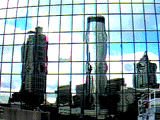Momus Amerikong, To The South

Chapter Three: Down South

Beyond the Jersey Turnpike, beyond Philadelphia and DC, they say people live who never shave their necks or allow their wrists to hang limp. And after corporate Atlanta and the twangy nightmare that is Nashville, only the austere Mies towers of Chicago can save our heroes from The Deep South...
'In Philadelphia I'm sure that I felt healthier...' so sang Mr Howard Devoto, and indeed things do take a salutory upturn when our heroes play their second college date at Swarthmore.
It proves to be the perfect antidote to the competitive unease of the Wesleyan show.

Arriving at night, the Momus band jokingly announce themselves as Mormons. 'That's all right,' reply the Swarthmore sophomores, 'we're Quakers'. And apparently they are.
Momus, Matt and Gilles dine at a Chinese restaurant where Gilles, who has lost his red woolly hat, finds a blue one to replace it. He decides it is a gift from god, and later detects traces of God's dandruff on the wool.
During the show, which is probably the best so far, there is a power cut and Gilles fills in by reading birth control tips from a Christian magazine, to the accompaniment of his battery operated Stylophone.
Although the young crowd, packed into a dank gothic chamber, has never heard of Momus, there is immediately a sense that they understand and share all the references in the songs, and are latching onto every word, completely in tune with the playfully transgressive spirit. These Quakers are clearly getting enough oats.

The following day our singer-songwriting friends drive to Washington DC and are ushered into their home for the next three days, an art deco riot grrrl indie den. Pam, who works closely with Gail O'Hara of Chick Factor, has a band and lives here 'too comfortably', planning vaguely to move to London some day.
Pam's band members drop by, announcing that they have just written 'a new C86 song' or 'a new section for that C81 song!' Orange Juice tapes play, and Momus has the spooky feeling that he's in an episode of Star Trek in which the crew of the Enterprise has been beamed down to the Glasgow of 1981.

At the DC show the stage is a bear pit, and Stephin Merrit is obliged to stand on a chair in order to be seen. The show seems successful enough until our friends listen to the cassette the sound man has made, and realise that they have been more wildly provocative and confrontational than they could ever have dreamed. Amidst the angry hubbub of ambient conversation picked up on the desk mike, our friends learn that they are 'freaks' and 'faggots' and their ass is going to get kicked.

There is a party for Gilles' (um...) 13th birthday back at Pam's, and Momus follows one beautiful guest, receptionist at the modern art gallery, from room to room attempting to photograph her. For he finds that, where once he would have aimed to kiss beautiful girls, now it is just as satisfying to engrave their zeroes and ones in the CCD array of his digital still camera. Furthermore, less trouble is to be had with their boyfriends.

In fact it is finally with this girl's boyfriend that he bonds, asking where he found 'that sweater that looks like a 70s airline logo'. Arrangements are made to spend Sunday at the Maryland Thrift Stores.

Pam's nylon-seeking device today will be an electric blue 60s Dodge.

But first there's lunch and a spot of CD shopping on a funky downtown street with a South American feel. The Europeans experience few qualms eating Ethiopian cuisine and eavesdropping on the surrounding tabletalk, which is all about the Clinton Fellatio Extravaganza.

Assuming a mantle of Toquevillesque gravitas after lunch, our friends ask Pam about the racial underpinnings of this city, which is 80% black. Are there any areas she wouldn't venture? Pam has lived in Washington alone for over ten years and has never been afraid to live and walk and drive around, but she does mention a very poor area called Anacostia where 'they won't just rob you, they'll hurt you. Those people are angry, they have every right to be, with no welfare and virtually no civic structure...' The flimsy Dodge, pointed towards Maryland, is soon passing exclusively black faces, on porches and in cars. There is a palpable anger in the kerbside body language, but it's black on black. It's people saying to each other 'If you're so smart, how come you're still in this slum, bro?'

They reach the Village Thrift Store, which is like an aircraft hangar. It stinks of fetid clothes, and most of its stock is ghastly pastel garb from last year's Bozo & Sixpack catalogue. The customers are tracksuited third world people, grown fat on American pay, dedicated to the inexpensive comforts of all-round expansion: larger televisions, larger fluffy toys, larger garden furniture, larger thighs... oh, and Little People Pals.

Here and there, however, Gilles and Momus exchange collusive, embarrassed glances with people like themselves: thin, furtive Ironists who have come here in search of the dead cast-offs of the unironic, recently-deceased original cast members of that decade of flamboyant dandyism, the 1970s. Back then, something mattered more than comfort: a largeness of gesture, a dangerous whiff of cocaine and sex.
Momus finds cool wear from the fast food sector: pizza T shirts and sta-pressed brown nylon Burger bar slacks (unisex McJob standard issue). Gilles lingers over the childrens' hand-drawn T shirts, which are as opaque in their private symbolism as Josef Beuys drawings.

At a second store, Laurel Thrift, Momus, fearless curator of his own Unfeasibly Bright Clothes Collection, spends $30 on yellow and orange Utilities Workwear. 'Now you can dig the street,' the cashier tells Momus ' - at night!'

But will the street dig him? When he wears this lot later, San Fransisco criminals will shout at him through their car windows and the Japanese tourists of the Roosevelt Hotel in Hollywood will nudge one another and say 'Sugoy!' Dressing up in cheap flash, reflects Momus (who seems to get more into the idea of Dandyism as he gets older) gets you all the attention of a celebrity... without the need for a single career-building compromise!.

That night there is a hilarious fashion show back at Pam's, mirrored by a documentary about Sonny and Cher.

The following day, posing like craggy presidential hopefuls at the White House, our two Beau Brummels meet some inspiring Washington dandies, a group of Blaxploitation hipsters called Kushti who are appearing in a Rock Opera and today are being photographed for publicity stills wearing huge heels, mens' skirts, and chomping suggestively on apples.
Because they are referential and hairdressery and flamboyant, there is instant rapport, and soon Momus and Gilles are adding freak power to the photos as extras.

Our friends are due in Atlanta, but spend a night in the forests of North Carolina with some Duke students.

Emily, their host, precipitates a spree of image capturing behaviour in Momus (who has two basic modes of being, both motivated by his admiration of beauty and intelligence: digital exhibitionist, or digital voyeur). She sits in charmingly mismatched pyjamas, with 'Je T'Aime (Moi Non Plus)' playing in the background, explaining the baroque chinoiserie of 18th century garden follies. There in the pristine, sunny forest, it is a moment of blissful and hyper-civilised synesthesia.
Refreshed, our friends continue to Atlanta: home of peaches, Coke and CNN.

Since Washington, where he caught a cold, Momus has been suffering a sudden worsening of his eye infection. His dandyism is from now on tempered with real suffering, and he will spend precious sightseeing time buried on the back seat of the Jeep, or sitting in the expensive waiting rooms of Corneal specialists.

Atlanta is a town without a soul. The art centers which dominate the downtown area are deeply corporate, which is why it's such a surprise to come on an exhibition as interesting as the Henry Darger show.

Recommended by Jason and Ryan, the Darger show documents one old man's obsession with little girls. In countless drawings and a 15,000 page literary epic, Darger spent his whole life telling the story of the Vivian Girls and their heroic struggle against the tin soldiers out to destroy them in the Glandeco-Angelinnian War Storm. At the fringes even of outsider art, this oeuvre opens up a fascinatingly detailed view of one man's zany obsession.

We escape the blandness of this city with a visit to the art school, where the kids are a lot more interesting looking than the strip mall crew who hang around Criminal Records...

...and the studios are pleasingly austere.

Atlanta is also dinner with Jack Mayfield, who tells a fascinating story of laser surgery... It's a club decorated in the style of early Bjork and Orb sleeves, it's cool Russian chick Olga, it's eating a birthday cake in a soulless hotel room at 8 in the morning, and above all it's an endless grid of streets with the same name... Peachtree. It's either very easy to be a taxi driver here... or impossible.

Nashville is nothing but Hard Rock Cafes and Planet Hollywoods. Momus despises this place for the cliches, the politics, and the ghastly boots.
They speed up north again, reaching Chicago by evening.

Their host is Janet Chen, who is an architect.

Mies Van Der Rohe, who designed the Illinois Institute Of Technology, sets the tone for this high tech, northern, modernist city. What would he say about those pointy boots in Nashville? Why, he'd simply stamp them out.

And what would Cynthia Plaster Caster, who casts Momus's penis in preparation for an exhibition at New York's Feature Gallery next year, say about those folks who are busy bombing abortion clinics down south? Something wilting, no doubt!

Next: citrus, sillicon and stardom beckon our heroes to California

Index






























